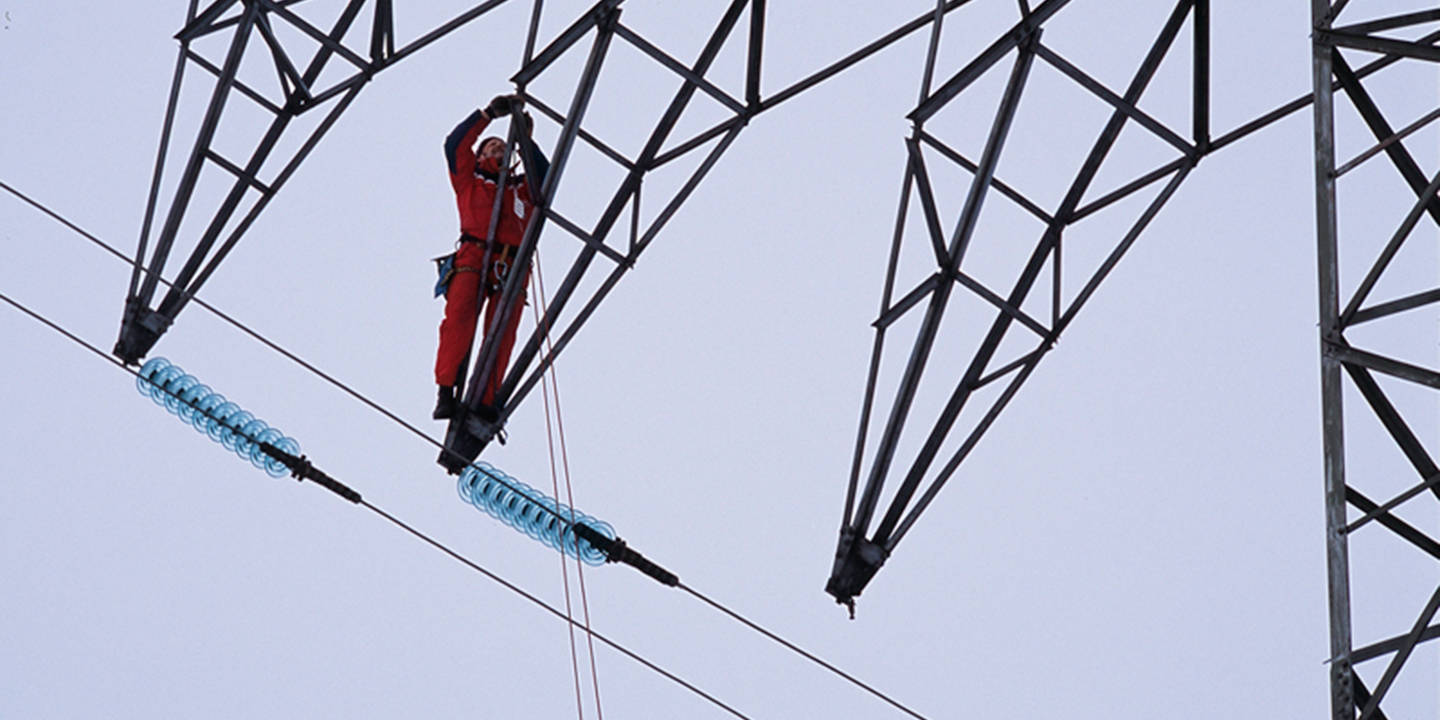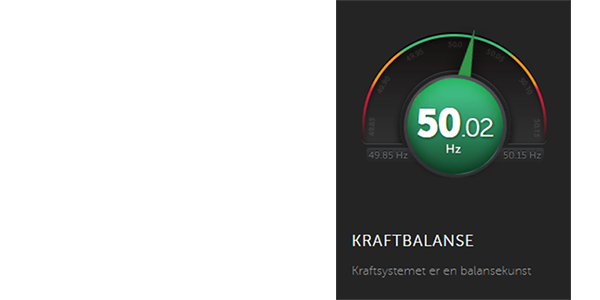Security of electricity supply is vital for a modern society, and requires a smoothly functioning power market. The market plays a key role in maintaining a constant balance between production and consumption. Both production-side and demand-side flexibility have a positive effect on security of supply, as do hydropower storage reservoirs and foreign trade in power. In addition, there must be a power grid with adequate transmission capacity.
In this context, energy security is defined as the capacity of the power supply system to meet the demand for electricity. Energy shortages or energy insecurity can arise when electricity production is reduced because supplies of primary energy (water, gas, coal, etc.) are in short supply.
Hydropower accounts for most of the Norwegian power supplies, and the resource base for production depends on the precipitation in a given year. This is a significant difference for the rest of Europe where security of supply is mainly secured through thermal power plants, with fuels available in the energy markets.
By using storage reservoirs, flexible hydropower plants can produce electricity even in periods when there is little precipitation and inflow is low. The large storage capacity makes it possible to even out production over years, seasons, weeks and days, within the constraints set by the licence and the watercourse itself.
Norway has a sound power balance and high power trading capacity, and therefore enjoys high energy security in the power system. Nevertheless, low water inflow and events outside Norway can make the situation difficult at times.
Statnett is responsible for developing measures to deal with highly strained power situations energy situations. These are known as ‘SAKS’ measures, and their purpose is to reduce the likelihood of rationing.
The Energy Act includes rules on electricity rationing, including enforced reductions of supply and requisitioning. Rationing can be introduced if required by extraordinary circumstances. The Norwegian Water Resources and Energy Directorate is the rationing authority and is responsible for planning and administration of any measures needed in connection with electricity rationing. The Directorate has issued regulations relating to rationing.
Adequacy is defined as the capacity of the power supply system to meet the instantaneous load, and is measured by the installed production capacity or grid capacity available. Capacity shortages arise in specific hours when consumption is high, in contrast to energy shortages, which may last for several weeks.
Electricity consumption means the amount of electricity used over time; electricity consumption at a specific moment in time is called the load. The power balance shows the relationship between the electricity supply and consumption at a particular moment. Although the load fluctuates with temperature, it has also shown a rising trend in line with the general rise in electricity consumption. In 1990, the maximum load in the Norwegian system was 18.42 GW. On 12 February 2021, a new consumption record was registered, and the load reached 25 230 MW in the morning (09:00–10:00). Thus, the peak load has risen since 1990, and has risen more rapidly than electricity consumption. This trend is expected to continue.
Satisfactory security of supply requires a power grid with adequate transmission capacity. To ensure that electricity supplies can be maintained in all circumstances, the grid system must be able to cope with both short- and long-term variability in production and consumption. It must be designed both to handle peaks in electricity consumption, which generally occur on the coldest days in cold years, and to allow for import of sufficient quantities of electricity for extended periods, for example in dry years.
To ensure security of supply, investments in the transmission grid are normally planned on the basis that a failure of one component in the system should not result in the interruption of supplies to end users (this is known as the N-1 criterion). However, this criterion is not a replacement for the cost-benefit analyses that are carried out when specific power lines are being planned. More information on how investments in the grid are planned can be found here.
Operational security means the capacity of the power supply system to withstand disturbances so that they do not lead to power outages or frequency or voltage deviations.
Operational security is concerned with avoiding interruptions to continuous operation of the power system right down to a time horizon of minutes and seconds. Faults in power lines, substations and control systems can affect operational security and result in service interruptions. There are various reasons why components of the system may fail, but weather-related incidents are an important reason for interruptions. You can read more about this below.
Statnett is responsible for coordinating the operation of the power supply system, capacity calculation, dealing with congestion, and facilitating power trade with other countries. As TSO, it must also take steps to ensure that the power market is efficient and that the quality of supply is satisfactory. The continual process of balancing the electricity system is vital for operational reliability. If an imbalance arises, the TSO takes steps to restore the balance, for example by adjusting production or consumption.
Electricity cannot easily be stored, so production must equal consumption at all times. This is called the instantaneous balance in the electricity system. The power market is an essential tool for maintaining the balance between electricity supply and demand. Statnett uses the results of daily price determination in the day-ahead market as the basis for planning and maintaining the instantaneous balance in the following 24-hour period.
The system frequency is a measure of the instantaneous balance in the power system, and is the same throughout the Nordic synchronous area, which comprises Norway, Sweden, Finland and parts of Denmark. The nominal system frequency is 50 Hertz (Hz), with a normal range of 49.9–50.1 Hz. The common system frequency means that an imbalance anywhere the synchronous area will affect the whole area. In addition, one country’s choices as regards grid investments, market solutions and operational security measures will affect the entire synchronous system. This makes it essential for the Nordic countries to cooperate closely.
Frequency quality can be measured using frequency deviations expressed as the number of minutes outside the normal variation range of 49.9–50.1 Hz. Frequency deviations can be caused by faults, imbalances related to changes in flow along interconnectors, or sudden changes in electricity production. To ensure that the instantaneous balance is maintained and prevent sudden changes or faults from causing frequency deviations or even power cuts, the TSO need to have reserves available. Reserves are often provided by flexible hydropower plants, where production can be regulated up or down to stabilise the system. To maintain operational security, TSOs must be able to access sufficient reserves through the balancing markets.
Many problems that can arise in the power system as a whole can also affect distribution grids. As people use electricity for more and more purposes, vulnerability to power cuts and problems related to quality of supply are increasing. For example, appliances such as induction hobs that draw more power are becoming increasingly popular, and more electricity produced from intermittent sources is being fed into lower grid levels. These trends are making operation of the distribution grid more challenging.
Investments in the distribution grid and measures to prevent the interruptions are important for security of supply. New technological and market solutions can also make the power supply system more resilient in future. You can read more about technological developments in the power supply system here.
The continuity of the electricity supply is depends on both the frequency and the duration of interruptions in the supply. In Norway, continuity of supply is stable and very good, and is close to 99.99 % in years without extreme weather events. It has never dropped below 99.96 % in any year since 1996, see the figure below.
Extreme weather events affect continuity of supply. In the figure, this is particularly obvious in 2011, when a winter storm caused a great deal of disruption because the high winds brought trees down on power lines.
In 2017, end users experienced an average of 1.6 brief and 1,7 longer power cuts. Longer power cuts are defined as those lasting more than three minutes. Important causes of power cuts are thunderstorms (lightning), wind causing trees or other vegetation to fall over power lines, and snow/ice on power lines. Various steps can be taken to reduce weather-related disruption of this kind. Maintaining a cleared corridor along power lines in forested areas reduces the risk of trees falling over the lines. Using underground cables is another possibility, and this is now the first choice for new power lines in the distribution grid in Norway.
It is not possible to provide 100 % continuity of the electricity supply. This would require an unreasonable level of investment in infrastructure, and for the same reason, no legal requirements have been introduced to provide 100 % continuity. Customers who are dependent on uninterrupted supplies must therefore ensure that they have emergency back-up power such as generators. Thus, society’s vulnerability to disruption of the power supply also depends on end user emergency preparedness.
Emergency preparedness in the power sector has become increasingly important as society grows more and more dependent on electricity. It is important both to take steps to prevent the disruption of supplies and to provide a rapid response if disruption does occur.
Requirements for the emergency preparedness system are set out in the Energy Act and the security and emergency planning regulations. There are rules on the resources that must be available for repairs, security measures, information security, protection of operational control systems and the Power Supply Preparedness Organisation.
The Power Supply Preparedness Organisation is responsible for restoring power supplies in an emergency. It is headed by the Norwegian Water Resources and Energy Directorate and also includes representatives of Statnett, grid companies, major electricity producers and larger district heating companies, and regional representatives of the power supply sector.
Human life and health and critical infrastructure and services are the priorities when restoring power supplies. Power companies are required to have robust communication systems, for example independent systems that make it possible for them to communicate with each other even if there is no mobile phone signal. Each company has an independent responsibility for maintaining effective security and preparedness systems.
The Norwegian Water Resources and Energy Directorate the supervisory body and is responsible for raising awareness of the need for emergency preparedness in the sector and for offering advice and guidance, exercises/training and information.


